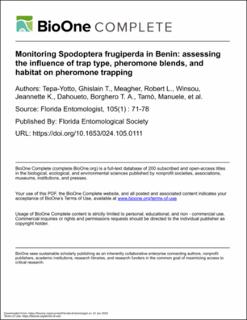| dc.contributor.author | Tepa-Yotto, Ghislain Tchoromi | |
| dc.contributor.author | Meagher, Robert L. | |
| dc.contributor.author | Winsou, Jeannette K. | |
| dc.contributor.author | Dahoueto, Borghero T. A. | |
| dc.contributor.author | Tamò, Manuele | |
| dc.contributor.author | Sæthre, May | |
| dc.contributor.author | Nagoshi, Rodney N. | |
| dc.date.accessioned | 2023-01-23T13:17:34Z | |
| dc.date.available | 2023-01-23T13:17:34Z | |
| dc.date.created | 2022-05-10T11:03:40Z | |
| dc.date.issued | 2022-04-12 | |
| dc.identifier.citation | The Florida entomologist. 2022, 105 (1), 71-78. | en_US |
| dc.identifier.issn | 0015-4040 | |
| dc.identifier.uri | https://hdl.handle.net/11250/3045380 | |
| dc.description.abstract | The fall armyworm, Spodoptera frugiperda (J. E. Smith) (Lepidoptera: Noctuidae), has now become a pest of global concern. Originally known to be endemic to the Western Hemisphere, its first detection in Africa was followed by spectacular outbreaks and spread to almost all sub-Saharan countries. The rapid incursion of S. frugiperda on maize (Zea mays L.; Poaceae) fields in Africa highlighted a crucial need for a comprehensive assessment of integrated pest management strategies in most smallholder farms. However, these strategies cannot successfully function without efficient monitoring and surveillance efforts. These trapping studies were designed to provide an indication as to whether pheromone trap-lure combinations and simple changes in landscape and agricultural practices might mitigate fall armyworm infestations. Our data show that the commercially available Unitrap was the most effective design for fall armyworm captures among the traps tested. The inexpensive home-made 2 L jar trap was capable of consistently collecting fall armyworm during the first season of relatively moderate fall armyworm density. However, the number of fall armyworm captured by home-made trap were several fold lower than by the Unitrap under all conditions, and almost no fall armyworm was captured during the second season by home-made 2 L jar when fall armyworm density was low. Substantial differences were observed among the pheromone blends with respect to numbers of fall armyworm and non-targets captured. The 4-component blend attracted the most fall armyworm under all conditions. The 2-component blend was the most selective, with no non-target species found during the second season experiments. | |
| dc.language.iso | eng | en_US |
| dc.publisher | BioOne | en_US |
| dc.rights | Navngivelse 4.0 Internasjonal | * |
| dc.rights.uri | http://creativecommons.org/licenses/by/4.0/deed.no | * |
| dc.title | Monitoring Spodoptera frugiperda in Benin: Assessing the influence of trap type, pheromone blends, and habitat on pheromone trapping | en_US |
| dc.title.alternative | Monitoring Spodoptera frugiperda in Benin: Assessing the influence of trap type, pheromone blends, and habitat on pheromone trapping | en_US |
| dc.type | Peer reviewed | en_US |
| dc.type | Journal article | en_US |
| dc.description.version | publishedVersion | |
| dc.source.pagenumber | 71-78 | en_US |
| dc.source.volume | 105 | en_US |
| dc.source.journal | The Florida entomologist | en_US |
| dc.source.issue | 1 | en_US |
| dc.identifier.doi | 10.1653/024.105.0111 | |
| dc.identifier.cristin | 2022990 | |
| cristin.ispublished | true | |
| cristin.fulltext | original | |
| cristin.qualitycode | 1 | |

